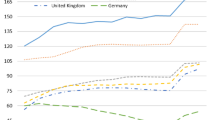Summary
This paper analyses optimal economic growth when the (exogenous) rate of population growth changes. The optimal growth path is characterized by a strikingly straightforward generalization of the traditional steady-state Golden Rule of Accumulation. The comparative statics results allow for a generalization of Samuelson's (1975) analysis of the lower-bound for the optimal rate of population growth. It is shown that under plausible assumptions the optimal savings rate follows an inverted U-shaped or U-shaped pattern during periods of demographic transition, according to whether the growth rate of births is falling or rising.
Similar content being viewed by others
References
Allen, R.G.D.,Mathematical Analysis for Economists, London, 1938.
Arthur, W.B. and G. McNicoll, ‘Optimal Time Paths with Age-Dependence: A Theory of Population Policy,’Review of Economic Studies, XLIV (1977), pp. 111–123.
Arthur, W.B. and G. McNicoll, ‘Samuelson, Population, and Intergenerational Transfers,’International Economic Review, XIX (1978), pp. 241–246.
Burmeister, E. and A.R. Dobell,Mathematical Theories of Economic Growth, London, 1970.
Cass, D., ‘Optimum Growth in an Aggregative Model of Capital Accumulation,’Review of Economic Studies, XXXII (1965), pp. 233–240.
Deardorff, A.V., ‘The Optimum Growth Rate for Population: Comment,’International Economic Review, XVII (1976), pp. 510–515.
Dorfman, R., ‘An Economic Interpretation of Optimal Control Theory,’American Economic Review, LIX (1969), pp. 817–831.
Miller, B.L., ‘The Effect on Optimal Consumption of Increased Uncertainty in Labor Income in the Multiperiod Case,’Journal of Economic Theory, XIII (1976), pp. 154–167.
Phelps, E.S., ‘The Golden Rule of Accumulation: A Fable for Growth-men,’American Economic Review, LI (1961), pp. 638–643.
Ritzen, J.M.M. and B.M.S. van Praag, ‘Golden Rules and Non-Stationary Population,’ Working Paper, Erasmus Universiteit Rotterdam, 1985.
Samuelson, P.A., ‘An Exact Consumption-Loan Model of Interest with or without the Social Contrivance of Money,’Journal of Political Economy, LXVI (1958), pp. 467–482. Samuelson, P.A., ‘The Optimum Growth Rate for Population,' International Economic Review, XVI (1975), pp. 531–538.
Samuelson, P.A., ‘The Optimum Growth Rate for Population: Agreement and Evaluations,’International Economic Review, XVII (1976), pp. 516–525.
Shell, K. ‘Optimal Programs of Capital Accumulation for an Economy in which there is Exogenous Technical Change,’ in: K. Shell (ed.), Essays in the Theory of Optimal Economic Growth, Cambridge, 1967.
Solow, R.M., ‘A Contribution to the Theory of Economic Growth,’Quarterly Journal of Economics, LXX (1956), pp. 65–94.
Swan, T.W., ‘Economic Growth and Capital Accumulation,’Economic Record, XXXII (1956), pp. 334–361.
Author information
Authors and Affiliations
Rights and permissions
About this article
Cite this article
van Imhoff, E., Ritzen, J.M.M. Optimal economic growth and non-stable population. De Economist 136, 339–357 (1988). https://doi.org/10.1007/BF01151808
Issue Date:
DOI: https://doi.org/10.1007/BF01151808




